

 |
||
 |
||
Vol. 9 (1): June 2006 |
||
Croatia / Cyprus / Greece / Madeira / Mauritania & Western Sahara / Spain / Turkey
Madeira
|
|||||||||||||||||||||
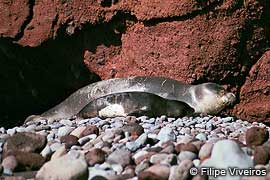 |
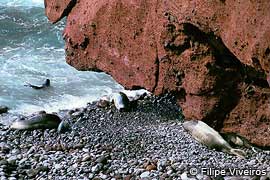 |
|
|
Mothers and pups on Tabaqueiro beach. |
||
Monitoring the area is also one way of avoiding possible accidents to pups once the females leave the beach to feed.
PNMS staff also confirmed that seals have alternated the use of this area with others, namely, one at the north of Tabaqueiro, Furadinho, that has not been in use since 1989.
Around the main island of Madeira, meanwhile, sightings of monk seals continue, and it has been confirmed that two resident seals are using one cave located on the south coast (information presented at the 20th Conference of the European Cetacean Society in Poland – see Recent Publications, this issue).
Lectures on “How to behave in the presence of a monk seal” are planned for all Madeira city councils. – Rosa Pires, Parque Natural da Madeira.
During the last 4 months, about 1,500 primary school students have been the focus of an awareness campaign carried out by the Fundación CBD-Hábitat in the city of Nouadhibou.
The campaign consisted of a specially designed story book, a presentation about the Cabo Blanco monk seal colony, and several environmental education games.
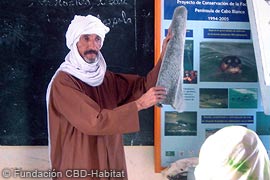 |
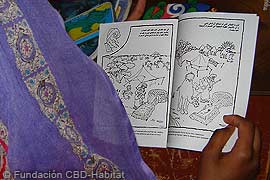 |
|
|
Schools programme in Nouadhibou. |
||
The book tells the story of a pilgrimage by an Arabic traveller along the Mediterranean and Atlantic coast from Mecca (Saudi Arabia) to Nouadhibou (Mauritania), and his search for a legendary and mysterious animal that he has heard used to exist along this entire coast but that has today almost disappeared. During his journey he collects the stories of fishermen about this animal, and the problems affecting the marine environment that brought about the seal’s disappearance (hunting, overfishing, coastal destruction, pollution, etc.). The tale ends as the pilgrim arrives in Nouadhibou and discovers the great Cabo Blanco colony, and asks the children to help in the protection of the animal. – Ana Maroto and Moulaye O. Haye, CBD-Habitat.
CBD-Habitat’s activities along the Mauritanian and south Moroccan coasts not only have the conservation of the endangered monk seal as their aim, but also an improvement in the life and working conditions of the impoverished artisanal fishermen of the area.
As such, many development actions are keyed into the Foundation’s conservation programme, such as courses on safety-at-sea and repair and maintenance of outboard engines; the construction of a fish market in the city, and similar initiatives [see Conservation actions on the Cabo Blanco Peninsula - a new approach, TMG 5 (2): November 2002].
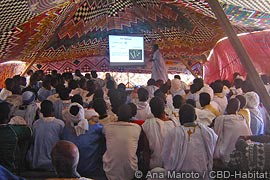 |
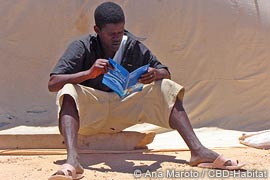 |
|
|
Seminar on sustainable fisheries. |
||
In a continuation of these activities, a sustainable fisheries seminar was organised in May this year in Mamghar, one of the largest villages of the Banc D’Arguin National Park. Also, a booklet on sustainable fisheries, adapted to the needs and experiences of local artisanal fishermen, was published by CBD-Habitat Foundation in French and Arabic.
A lack of knowledge among most of these artisanal fishermen leads to fishing practises that damage the sustainability of the resources they exploit, thereby jeopardising their own future livelihoods. The seminar and other related activities aims to bring the negative consequences of these activities to their attention, whilst also proposing alternatives that favour a continued and sustainable use of the marine environment. – Hamdi M’Barek, Michel Cedenilla and Pablo Fernández de Larrinoa, CBD-Habitat.
Further information:
CBD-Habitat. 2006. Pêcher de façon responsible. Textes: Pablo Fdez. de Larrinoa y Miguel A. Cedenilla. Fundación CBD-Habitat, Madrid: 1-16. [PDF ![]() 9.7 MB]
9.7 MB]
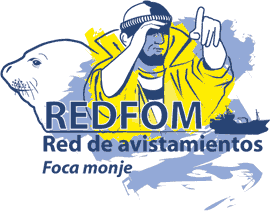 |
|
|
REDFOM logo. |
Under an agreement between the Mauritanian government and the European Commission, the Spanish industrial fleet fishing in Mauritanian waters will take part in a monk seal sightings network created by CBD-Habitat and the Spanish Ministry of Agriculture and Fisheries, with the financial support of the Biodiversity Foundation.
This initiative, that allows the fishermen to easily report monk seal sightings in the area, seeks to make up for a current lack of knowledge about monk seal feeding grounds in Mauritania, and the presence of the species far from shore.
Awareness material, specifically designed for the purpose, will be distributed among the industrial fishing fleet. Talks will also be organised in the various Spanish fishing harbours in order to explain to fishermen the means by which a monk seal sighting should be communicated to the network.
Artisanal fishermen along the Cabo Blanco-Cabo Barbas coastline have been providing monk seal sightings since 2001. – Pablo Fernández de Larrinoa and Mercedes Muñoz, CBD-Habitat.
Monk seal translocation – capturing animals in one place with the intention of repopulating another – has long been a controversial issue.
Besides the highly complex practical problems involved – ranging from risks to candidate animals during the capture procedure to the suitability of the translocation site – there are also fundamental questions involving population biology and management philosophy. These, in turn, pose numerous and complex questions of their own. Do mathematical models, for example, indicate a heightened risk of decline or even of extinction to the donor population by removal of the candidate animals? At the chosen recipient site, have factors that caused the disappearance of the original monk seal population – such as killing by fishermen, overfishing or destruction of habitat – been adequately addressed? And if translocated animals have to remain semi-captive in order to ensure they do not leave the translocation area – how will that affect the overall viability and value of the plan?
Differing philosophical approaches to conservation may also prove contentious, pitting those favouring in situ efforts – such as the establishment and operation of marine protected areas – against those advocating ex situ approaches, such as translocation or captive breeding.
Opposition is likely to be that much more intense if it is perceived that translocation is proceeding to the detriment of in situ conservation efforts. That, unfortunately, would be the case at the present time, with key monk seal conservation projects around the Mediterranean languishing because of inadequate funding.
Convincing the sceptics that translocation makes sense would also run against the argument that – where adequately protected – monk seal populations previously on the brink of extinction have shown promising signs of recovery (as in the case of Madeira).
Apparently in recognition of the scientific and political hurdles involved, two recently announced Spanish translocation initiatives are taking a longer term view in their aim of seeing monk seals back in Spanish waters — apparently in the belief that sceptics can be won over both by debate and action on the ground.
The first project, supported by the Balearic Islands government, eventually aims to reintroduce monk seals to one of the species’ former haunts in the archipelago, the island of Cabrera, now a protected area. Supporters of the project emphasise that the first priority is not translocation per se, but ensuring that various habitat, management and social issues have been adequately addressed that would make the area hospitable to the species. According to Joan Mayol, Head of the Service of Species Protection of the Balearic Islands Government, “we want to recover the Balearics for the monk seal and be ready when monk seals are recovered and ready for the Balearics.”
By taking this approach, the Balearic Islands is also broadly complying with UNEP/MAP recommendations that seek to ensure that historical monk seal habitat is sufficiently protected and restored so as to encourage any possible natural recolonisation by the species.
The second project aims to bring monk seals to Cap de Creus, with recent press coverage in Spain and on the Internet indicating a target date of 2014. The project is being fronted by the Fundación Territorio y Paisaje, the foundation of a Catalan savings bank, the Caixa de Cataluny.
According to press reports, it would foresee 15 monk seals being taken from the Cap Blanc colony in Mauritania/Western Sahara and reintroduced to Cala Jugadora, Cadaqués, in the Costa Brava, due north of the Balearics. Other potential translocation sites that have been mentioned in the press include the Canary Islands and Cabo de Gata, east of Almería. Together with Cabrera, it is speculated that this south-north running chain would create “several stable populations”, encouraging individuals to travel between the colonies, thus reinforcing them.
Apparently recognising that there could be local hostility among fishermen to the plan, the director of the Fundación Territorio y Paisaje, Jordi Sargatal, suggested that “reconciliation projects” could now be created in fishing communities to mitigate any such enmity towards the return of the seals.
Should translocation ever move to the planning stage, the perceived status of the donor population in Mauritania/Western Sahara is likely to become a serious focus of debate. This, the world’s largest surviving monk seal colony, was reduced by two thirds in 1997 in a mass die-off variously attributed to a toxic algal bloom and a morbillivirus. Currently estimated to number 150 individuals, the population is still only at half strength compared to pre- die-off figures.
Translocation plans are also likely to face criticism, as well as uncompromising scrutiny, from a number of sources. Ironically, the most vociferous of these may be Spanish in origin.
In Madrid, the Spanish Ministry of Environment – which has played a key leadership role in advancing the CMS Monk Seal Recovery Plan in the Eastern Atlantic [see Third Monk Seal Recovery Plan meeting held in Dakhla, TMG 7 (2): November 2004], as well as in promoting conservation of the species in situ in Mauritania/Western Sahara — would be required to give its official blessing to the reintroduction.
The Madrid-based Fundación CBD-Hábitat, which leads in situ conservation efforts in the area, has expressed reservations about the viability of the draft plans, at least as they currently stand.
Another, and perhaps more vocal, critic is Alex Aguilar of the University of Barcelona, who, prior to the 1997 mass die-off, led an EU-LIFE funded project to assess the viability of a similar translocation initiative involving Isla de Lobos in the Canary Islands.
Aguilar cites several objections to the Cap de Crues and Cabrera projects, among them:
Aguilar argues that it is at Cap Blanc in Mauritania/Western Sahara that the monk seal needs and deserves protection. A previous and much-contested plan to “rescue” pups pre-emptively in an effort to reduce a high mortality caused by winter storm surges into the Cap Blanc breeding caves may have been used previously as an added justification for translocation. In this scenario, pups that would otherwise be fated to drown would instead be rescued and used to supply translocation needs. Criticism of the plan – not least of all, the impossibility of predicting which pups would have been killed by a storm surge and which would have survived – has seen it fade from view of late. In addition, an earlier than normal pupping season during the years 2004 and 2005 led to a drop in pup mortality from 40-50% to 30% [see Pupping season on the “Coast of the Seals” 8 (2): December 2005].
The debate between the two sides, one favouring further examination of translocation as a valid conservation tool, and the other objecting on a variety of scientific and technical grounds, looks all set to continue in the months and years ahead.
In keeping with its tradition of fostering free and open debate within the monk seal conservation community, TMG intends to continue presenting these and other wide-ranging views in future editions.
If you wish to comment on this story, or on our Cover Story from the Balearic Islands [The Government of the Balearic Islands – Working towards the recovery of the Mediterranean monk seal], please contact the Editor.
Press coverage
La foca monje volverá a Cadaqués. El País, 02-01-2006.
http://www.elpais.es/articulo/elpepiautcat/20060102elpcat_8/Tes/foca/monje/volver%E1/Cadaqu%E9s
Pretenden reintroducir focas en el Cap de Creus en 2014. 2006. Wanadoo ES.
http://actualidad.wanadoo.es/carticulos/112555.html.
La Fundación Territorio y Paisaje proyecta reintroducir focas monje en el cabo de Creus en el año 2014. 2005. Consumer.es, 28 de diciembre de 2005.
http://www.consumer.es/web/es/medio_ambiente/2005/12/28/148149.php
Les foques de la discòrdia. 2006. El Temps, Número 1132, 21 febrer 2006.
http://www.eltemps.net/art2.php?num_id=31
Wildtalk Spain # 88: Return of the Mediterranean monk seal. 9 January 2006.
http://www.wild-spain.com/wsbriefs.php and http://archive.mail-list.com/wildtalk/msg00088.html
On monk seal translocation
González, L.M., B. Heredia, A. Araujo, I. Robinson, J. Worms, P.S. Miller and U. Seal (eds.). 2002. Population and Habitat Viability Assessment for the Mediterranean Monk Seal (Monachus monachus) in the Eastern Atlantic. Workshop Report. Apple Valley, MN: IUCN/SSC Conservation Breeding Specialist Group: 1-126. [PDF ![]() 1.4MB]
1.4MB]
Johnson, W.M. and D.M. Lavigne. 1998. The Mediterranean Monk Seal. Conservation Guidelines. Multilingual Edition. International Marine Mammal Association Inc., Guelph, Ontario, Canada: 1-152. [PDF ![]() 955 KB]
955 KB]
TMG. 2003. Mystery at RAC/SPA Time for pup-catching, says its anonymous expert(s). The Monachus Guardian 6 (2): December 2003.
Mediterranean News continues with Turkey...
Copyright © 2006 The Monachus Guardian. All Rights Reserved |